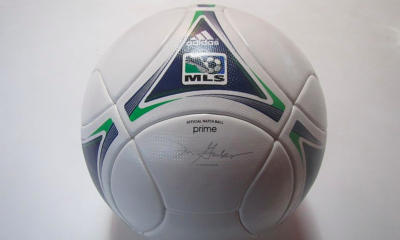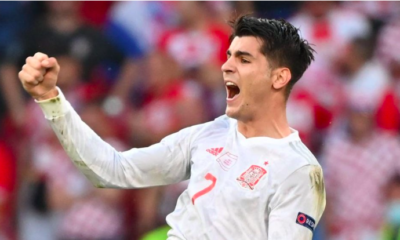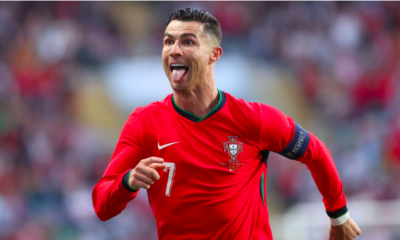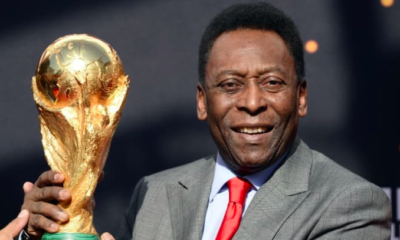Soccer
What Are The Basics Rules Of Football? (Soccer)

What Are The Basics Rules Of Football? (Soccer)
Football, also known as soccer in some parts of the world, is a sport cherished by millions for its simplicity, skill, and unifying power. Whether played on sprawling professional pitches or neighborhood streets, the game captivates hearts and ignites passions across continents. However, to fully appreciate the artistry and drama unfolding on the field, one must first grasp the fundamental rules that govern the game.
In this comprehensive guide, we’ll embark on a journey to understand the basics of football (soccer), exploring the rules and regulations that shape every match and define the essence of this beloved sport. From the objective of scoring goals to the nuances of fouls and offside, let’s unravel the intricacies of football and unlock the secrets of the beautiful game.
Objective:
At its core, the objective of football is simple yet profound: to score more goals than the opposing team within the allotted time of the match. A goal is scored when the entire ball crosses the goal line between the goalposts and beneath the crossbar, either by a player’s direct shot or a deflection off another player.
The team with the highest number of goals at the end of the game emerges victorious. This straightforward objective fuels the intense competition and strategic maneuvers seen on the pitch as teams strive to outmaneuver their opponents and secure victory.
Team Composition:
A standard football match comprises two opposing teams, each consisting of 11 players on the field at any given time, including one goalkeeper. Teams typically organize their players into specific positions, each with distinct roles and responsibilities. These positions often include defenders, midfielders, forwards, and the goalkeeper.

- Goalkeeper (GK): Positioned within the goal area, the goalkeeper’s primary role is to prevent the opposing team from scoring by intercepting shots on goal. They are the only player permitted to handle the ball with their hands within the penalty area, subject to certain restrictions.
- Defenders: Defenders play a crucial role in protecting their team’s goal and thwarting the opposition’s attacks. They aim to intercept passes, block shots, and dispossess opposing players to regain possession of the ball. Common defensive positions include center-backs, full-backs, and wing-backs.
- Midfielders: Midfielders occupy the central area of the pitch and serve as the link between defense and attack. They are responsible for distributing the ball, maintaining possession, and supporting both defensive and offensive phases of play. Midfield positions include defensive midfielders, central midfielders, and attacking midfielders.
- Forwards: Forwards, also known as strikers or attackers, are tasked with scoring goals for their team. They utilize their speed, agility, and skill to penetrate the opposing team’s defense, create goal-scoring opportunities, and convert chances into goals. Forward positions may include center-forwards, wingers, and attacking wingers.
Each player’s position and role contribute to the overall team strategy, with teamwork, communication, and coordination being essential for success on the field. Additionally, teams may make substitutions throughout the match to replace tired or injured players or to introduce fresh legs and tactical changes.
Duration:
A standard football match consists of two halves, each typically lasting 45 minutes, for a total game duration of 90 minutes. However, the actual playing time often extends beyond this due to stoppages for various reasons, including substitutions, injuries, and time-wasting tactics by players.
- Halftime: At the conclusion of the first half, teams take a brief break known as halftime, during which players have the opportunity to rest, receive tactical instructions from coaches, and hydrate. Halftime typically lasts for 15 minutes, although the duration may vary depending on the competition’s rules and regulations.
- Added Time (Injury Time): The referee may add additional time to the end of each half, known as injury time or stoppage time, to compensate for the time lost due to stoppages during regular play. The duration of added time is determined by the referee based on factors such as substitutions, injuries, and time-wasting tactics. The fourth official displays the amount of added time indicated by the referee, and play continues until the specified period elapses.
- Extra Time (Overtime): In knockout competitions or matches where a winner must be determined, such as cup ties or playoff games, extra time may be played if the score remains level at the end of regulation time. Extra time typically consists of two additional periods of 15 minutes each, with teams switching ends after the first period. If the score remains tied after extra time, the match may proceed to a penalty shootout to determine the winner.
- Penalty Shootout: In the event of a draw after extra time, a penalty shootout is conducted to determine the winner of the match. Each team selects five players to take penalty kicks alternately against the opposing goalkeeper from the penalty spot. The team that scores the most goals wins the shootout and the match. If the scores remain level after five rounds of penalties, the shootout may proceed to sudden death, where each team takes one penalty at a time until a winner is determined.
Field of Play:
The football pitch, often referred to as the field of play, is a rectangular surface where matches take place. Understanding the dimensions and markings of the field is crucial for players, officials, and spectators alike.

- Dimensions: The standard dimensions of a football pitch can vary but generally fall within a range specified by the Laws of the Game. The length of the field must be between 100 meters (110 yards) and 110 meters (120 yards), while the width should be between 64 meters (70 yards) and 75 meters (80 yards). International matches typically adhere to the larger end of these ranges, while pitches used in domestic competitions may vary.
- Goalposts: At each end of the field, there are goalposts consisting of two upright posts, equidistant from the corner flags, joined by a crossbar. The goalposts must be positioned on the goal line and securely anchored to the ground. The standard width of the goalposts is 7.32 meters (8 yards), and the height from the ground to the lower edge of the crossbar is 2.44 meters (8 feet).
- Penalty Area: The penalty area, also known as the 18-yard box, is a rectangular area located in front of each goal. It extends 16.5 meters (18 yards) from the goal line into the pitch and is 40.3 meters (44 yards) wide. Within the penalty area, the goalkeeper has special privileges, such as handling the ball with their hands (subject to certain restrictions) and protection from certain types of contact.
- Penalty Spot: In the center of each penalty area is the penalty spot, which is 11 meters (12 yards) from the goal line. Penalty kicks are taken from this spot during regular play and penalty shootouts.
- Goal Area: The goal area, also known as the six-yard box, is a smaller rectangular area within the penalty area. It extends 5.5 meters (6 yards) from the goal line and is 18.3 meters (20 yards) wide. Goal kicks are taken from any point within this area.
- Corner Arc: Each corner of the field features a quarter-circle arc with a radius of 1 meter (1 yard). When taking a corner kick, the ball must be placed within this arc.
- Halfway Line: The halfway line divides the field into two equal halves and is located midway between the two touchlines. It is marked across the width of the field and is used to denote the halfway point for kick-offs at the start of each half and after goals are scored.
Understanding the dimensions and markings of the field of play is essential for players to navigate the pitch effectively and for officials to enforce the rules of the game accurately. Additionally, spectators can better appreciate the strategic elements of play by familiarizing themselves with the layout of the field.
Start and Restart:
In football (soccer), matches begin and resume play through various methods, each serving a specific purpose within the game’s framework. Understanding these start and restart procedures is essential for players, officials, and spectators alike.
- Kick-off: The match begins with a kick-off from the center of the field. Before kick-off, the referee tosses a coin, and the team that wins the toss decides which goal to attack in the first half or whether to kick-off. The opposing team takes the kick-off, with all players positioned in their respective halves of the field. The ball must move forward into the opposing team’s half for play to commence.
- Drop Ball: If play is stopped for reasons other than those covered by other restart methods, the referee may choose to perform a drop ball. In this scenario, the referee drops the ball at the spot where it was when play was stopped, and one player from each team contests possession once the ball touches the ground.
- Goal Kick: When the attacking team plays the ball over the opposing team’s goal line, but not into the goal, and the defending team was the last to touch it, a goal kick is awarded to the defending team. The ball is placed anywhere inside the six-yard box and kicked into play by a defending player.
- Corner Kick: If the defending team plays the ball over its own goal line, but not into the goal, and the attacking team was the last to touch it, a corner kick is awarded to the attacking team. The ball is placed within the corner arc at the nearest corner of the field, and a member of the attacking team takes the kick.
- Free Kick: When a foul or infringement occurs, the opposing team is awarded a free kick. The location of the free kick depends on the nature and location of the offense. The ball is stationary, and opponents must maintain a specified distance from the ball until it is in play.
- Penalty Kick: If a foul punishable by a direct free kick occurs inside the penalty area, the opposing team is awarded a penalty kick. The ball is placed on the penalty spot, and only the goalkeeper is allowed to defend the goal.
Understanding these start and restart procedures is crucial for players, officials, and spectators to follow the flow of the game and to ensure fair play. By adhering to these rules, football matches can be conducted smoothly and fairly, allowing for an exciting and competitive sporting spectacle.
Ball In and Out of Play:
In football (soccer), the concept of the ball being in or out of play dictates the flow of the game and determines when certain actions, such as scoring goals or making substitutions, can occur. Understanding the rules regarding the ball’s status is fundamental for players, officials, and spectators alike.
- In Play: The ball is considered in play when it is within the boundaries of the field and has not crossed the goal line or touchline completely. During this time, players can legally maneuver the ball, pass it between teammates, or attempt to score goals.
- Out of Play: The ball is deemed out of play when it crosses either the touchline (side boundary) or the goal line (end boundary), either on the ground or in the air, or when the referee stops play for an infringement, injury, or any other reason.
- Throw-In: When the ball crosses the touchline, a throw-in is awarded to the opposing team from the spot where it exited the field. The player taking the throw-in must have both feet on the ground and deliver the ball with both hands from behind their head.
- Goal Kick: If the attacking team plays the ball over the defending team’s goal line, but not into the goal, and the defending team was the last to touch it, a goal kick is awarded to the defending team. The ball is placed anywhere inside the six-yard box and kicked into play by a defending player.
- Corner Kick: If the defending team plays the ball over its own goal line, but not into the goal, and the attacking team was the last to touch it, a corner kick is awarded to the attacking team. The ball is placed within the corner arc at the nearest corner of the field, and a member of the attacking team takes the kick.
- Offside: While not directly related to the ball being in or out of play, the offside rule dictates when a player is in an offside position if they are nearer to the opponent’s goal line than both the ball and the second-to-last opponent when the ball is played to them. If a player is offside when the ball is played to them, play is stopped, and a free kick is awarded to the defending team.
By understanding the concepts of the ball being in and out of play, players, officials, and spectators can follow the flow of the game and recognize when certain actions, such as restarts or scoring opportunities, are possible. This knowledge contributes to a deeper appreciation and comprehension of the world’s most popular sport, football.
Scoring:
Scoring in football (soccer) is the ultimate objective of the game, where teams compete to accumulate goals by successfully putting the ball into their opponent’s net. Understanding the rules and methods of scoring is crucial for players and fans alike to appreciate the excitement and dynamics of the sport.
- Goal: The primary method of scoring in football is by successfully propelling the ball past the opposing team’s goalkeeper and into their net. A goal is awarded when the entire ball crosses the goal line between the goalposts and under the crossbar, regardless of how it enters the goal, whether by direct shot, deflection off a player, or an own goal by a defender.
- Value: Each goal scored during a match contributes one point to the scoring team’s total. At the end of the game, the team with the highest number of goals is declared the winner.
- Assist: In addition to the scorer, credit for a goal is often given to the player who provided the pass or play that directly led to the goal. This player is typically referred to as the “assister” and is recognized for their contribution to the scoring play.
- Hat-Trick: A hat-trick occurs when a player scores three goals in a single game. It is considered a significant achievement and is often celebrated as a remarkable individual feat.
- Own Goal: Occasionally, a goal may be scored inadvertently by a defending player, known as an own goal. In such cases, the goal is credited to the attacking team, and the defending player is attributed with the own goal.
- Penalty Kick: A penalty kick is awarded to the attacking team if a defensive player commits a foul inside their own penalty area. It allows the attacking team to take a shot on goal from the penalty spot, 12 yards away from the goal line, with only the goalkeeper to beat. A successful penalty kick results in a goal for the attacking team.
- Free Kick Goal: Goals can also be scored directly from a free kick if the player taking the kick strikes the ball into the net without it touching another player. Free kicks are awarded for fouls committed by the opposing team, and the location of the kick depends on the nature and location of the foul.
Understanding the intricacies of scoring adds to the excitement and drama of football matches, as teams strive to outmaneuver their opponents and capitalize on scoring opportunities. Whether through precise passing, skillful dribbling, or powerful strikes, scoring goals remains the ultimate reward for players and the pinnacle of achievement in the world’s most beloved sport.
Fouls and Misconduct:
In football (soccer), maintaining fair play is essential to ensure the integrity and safety of the game. Understanding fouls and misconduct is crucial for players, referees, and fans alike, as they dictate the rules of engagement on the field and the consequences for violations.
- Fouls: A foul occurs when a player commits an offense against an opponent that is deemed to be unfair or illegal by the referee. There are various types of fouls, each with its own specific implications and penalties. Common fouls include:
- Tripping or Tackling: Intentionally or recklessly obstructing an opponent by tripping or attempting to tackle them without making contact with the ball.
- Pushing or Holding: Using physical force to push, hold, or impede an opponent’s movement, whether during a challenge for the ball or in open play.
- Charging: Charging into an opponent with excessive force or in a dangerous manner, especially from behind or without making a genuine attempt to play the ball.
- Handball: Deliberately handling the ball with any part of the arm or hand, excluding the goalkeeper within their penalty area.
- Foul Play: Engaging in conduct deemed dangerous, violent, or unsporting, such as striking, kicking, elbowing, or spitting at an opponent.
- Obstruction: Preventing an opponent from playing the ball by obstructing their movement without making contact, such as standing in their path or shielding the ball illegally.
- Misconduct: In addition to fouls, players may also be penalized for misconduct, which refers to actions that violate the rules of the game but do not necessarily involve direct contact with an opponent. Misconduct includes:
- Yellow Card: A caution issued by the referee to a player as a formal warning for unsporting behavior, dissent, persistent fouling, or other minor infractions. A player receiving two yellow cards in the same game is shown a red card and subsequently ejected from the match.
- Red Card: A dismissal from the game following a serious offense or accumulation of two yellow cards. A red card may be shown for violent conduct, serious foul play, spitting, offensive language, denying an obvious goal-scoring opportunity, or other egregious infractions. A team playing with fewer than eleven players due to a red card is said to be playing with a numerical disadvantage or “down a man.”
- Sending Off: When a player receives a red card, they are immediately ejected from the game and cannot be replaced by a substitute. The team must continue playing with one fewer player for the remainder of the match.
- Suspension: Players who receive a red card may face additional disciplinary action, including fines, extended suspensions, or bans from future matches, depending on the severity of the offense and the governing body’s regulations.
Understanding fouls and misconduct is essential for players to adhere to the rules of fair play and for referees to enforce them consistently and impartially. By promoting sportsmanship, respect, and safety on the field, football maintains its status as the beautiful game enjoyed by millions worldwide.
Offside:
In football (soccer), the offside rule is a fundamental aspect of the game that governs the positioning of players in relation to the opposing team’s goal. Understanding the offside rule is crucial for players, coaches, referees, and fans alike, as it plays a significant role in determining the flow of play and preventing unfair advantages.
- Definition: The offside rule is designed to prevent players from gaining an unfair advantage by positioning themselves closer to the opponent’s goal line than both the ball and the second-last defender when the ball is played to them.
- Offside Position: A player is in an offside position if they are nearer to the opponent’s goal line than both the ball and the second-last opponent, usually the last defender, at the moment the ball is played to them by a teammate.
- Active Involvement: Being in an offside position alone does not constitute an offense. A player is only penalized for offside if they are deemed to be actively involved in the play by:
- Interfering with Play: Playing or touching the ball passed or touched by a teammate.
- Interfering with an Opponent: Preventing an opponent from playing or being able to play the ball by obstructing their line of vision, challenging them for the ball, or making a movement that deceives or distracts them.
- Gaining an Advantage: Benefitting from being in an offside position by gaining control of the ball, playing a pass, or scoring a goal.
- Exceptions: Certain situations are exempt from the offside rule, including:
- Goal Kicks: A player cannot be offside directly from a goal kick.
- Throw-Ins: A player cannot be offside directly from a throw-in.
- Corner Kicks: A player cannot be offside directly from a corner kick.
- Receiving the Ball from Opponents: A player cannot be offside if they receive the ball directly from a throw-in, goal kick, or corner kick taken by an opponent.
- Offside Decision: Offside decisions are made by the assistant referees (formerly known as linesmen) positioned along the sidelines. If a player is judged to be in an offside position and involved in active play when the ball is played to them, the assistant referee raises their flag to signal the infraction.
- Free Kick: When an offside offense occurs, the opposing team is awarded an indirect free kick from the spot where the offside player was positioned when the ball was played to them.
Understanding the offside rule adds depth and strategy to the game of football, requiring players to time their runs and movements carefully to avoid penalties while seeking to exploit gaps in the opponent’s defense. By promoting fairness and balance between attacking and defending teams, the offside rule contributes to the beauty and excitement of the sport.
Penalty Kicks:
In football (soccer), a penalty kick is a pivotal moment that can significantly impact the outcome of a match. Understanding the rules governing penalty kicks is essential for players, coaches, referees, and fans, as they often decide crucial moments in the game.
- Awarding a Penalty Kick:
- A penalty kick is awarded when a defending player commits a foul punishable by a direct free kick inside their own penalty area, regardless of the position of the ball, if the foul is committed while the ball is in play.
- Location:
- The penalty kick is taken from the penalty mark, which is positioned 12 yards (11 meters) from the goal line and directly in front of the goal.
- Procedure:
- The player taking the penalty kick, known as the penalty taker, places the ball on the penalty mark.
- All players, except the penalty taker and the defending goalkeeper, must be outside the penalty area and at least 10 yards (9.15 meters) from the penalty mark until the ball is kicked.
- The goalkeeper must remain on their goal line until the ball is kicked.
- The referee signals for the penalty kick to be taken once all players are in the correct position.
- Taking the Kick:
- The penalty taker approaches the ball and kicks it towards the goal.
- The penalty taker must kick the ball forward and may not touch it again until it has been touched by another player.
- The kick is considered complete once the ball has been kicked and clearly moves.
- Retakes:
- If the penalty taker infringes the laws of the game (e.g., feinting to kick the ball once the run-up has started), the penalty kick is retaken.
- If the defending team commits an offense before the ball is in play (e.g., encroachment into the penalty area), the penalty kick may be retaken if the original kick does not result in a goal.
- If the ball rebounds off the goalpost, crossbar, or goalkeeper and is touched by any player before it is in play, the penalty kick is retaken.
- Goal or Miss:
- If the ball enters the goal, a goal is awarded, and play restarts with a kick-off to the defending team.
- If the ball misses the goal, goes out of play, or is saved by the goalkeeper, play restarts with a goal kick, corner kick, or throw-in, depending on the circumstances.
Penalty kicks offer an exciting and tense moment in football, often testing the skill and composure of both the penalty taker and the goalkeeper. With the outcome of the match potentially hanging in the balance, penalty kicks can provide thrilling moments of drama for players and spectators alike.
Conclusion:
Understanding the basic rules of football is essential for both fans and players to fully engage with the sport. By grasping the fundamental principles outlined above, individuals can develop a deeper appreciation for the intricacies of the game and enjoy the excitement of football matches with greater clarity and understanding.

Soccer
Brazil Coach Dorival Junior Takes Full Responsibility for Copa América Exit Against Uruguay

Brazil Coach Dorival Junior Takes Full Responsibility for Copa América Exit Against Uruguay
Brazil’s journey in the Copa América 2024 ended in disappointment as they were knocked out by Uruguay in the quarter-finals. The Brazilian national team’s head coach, Dorival Junior, has taken full responsibility for the team’s early exit. In this article, we delve into the details of the match, the reactions from both teams, and the implications for Brazil’s football future.
Match Overview
The match between Brazil and Uruguay was highly anticipated, with both teams having a storied history in South American football. The game took place at the iconic Maracanã Stadium, adding to the intensity of the encounter. Uruguay managed to secure a 2-1 victory, thanks to goals from Edinson Cavani and Federico Valverde. Brazil’s lone goal came from Neymar Jr., who showed moments of brilliance but could not carry his team to victory.
Dorival Junior’s Reaction
Taking Full Responsibility
In the post-match press conference, Dorival Junior was candid about Brazil’s performance. “I take full responsibility for our exit,” he stated. “We had a game plan, but unfortunately, we couldn’t execute it as intended. Uruguay played a great game, and we have to acknowledge their strength and strategy.”
Tactical Decisions
Critics and fans alike have questioned some of the tactical decisions made by Dorival Junior during the match. The decision to start with a more defensive lineup raised eyebrows, especially considering Brazil’s attacking prowess. “In hindsight, we could have been more aggressive from the start,” Dorival admitted. “However, we believed that a solid defense would give us the best chance against a strong Uruguayan side.”
Uruguay’s Performance
Uruguay’s victory was a testament to their resilience and tactical acumen. Under the guidance of coach Diego Alonso, Uruguay executed their game plan to perfection. Edinson Cavani, with his wealth of experience, opened the scoring with a clinical finish, while Federico Valverde’s goal showcased the team’s ability to capitalize on Brazil’s defensive lapses.
Key Players
- Edinson Cavani: The veteran striker’s goal was crucial in setting the tone for Uruguay. His leadership on the field was evident as he constantly motivated his teammates.
- Federico Valverde: The young midfielder’s goal was a highlight of the match. His ability to control the midfield and transition from defense to attack was pivotal in Uruguay’s success.
- Fernando Muslera: The Uruguayan goalkeeper made several key saves, denying Brazil’s forwards and maintaining Uruguay’s lead.
Brazil’s Performance
Despite the loss, there were some positive takeaways for Brazil. Neymar Jr.’s performance was a bright spot, as he constantly threatened Uruguay’s defense. However, the team as a whole struggled to find cohesion and break down Uruguay’s organized defense.
Areas for Improvement
- Defensive Organization: Brazil’s defense looked vulnerable at times, particularly on counter-attacks. Improving defensive coordination will be crucial for future tournaments.
- Midfield Creativity: The midfield lacked creativity and struggled to provide the forwards with quality opportunities. Finding a balance between defense and attack in the midfield will be essential.
- Finishing: Despite creating several chances, Brazil’s forwards were unable to convert them into goals. Clinical finishing will be a focus in upcoming training sessions.
Reactions from Players
Neymar Jr.
Neymar, Brazil’s star player, expressed his disappointment after the match. “We gave it our all, but it wasn’t enough,” he said. “We need to learn from this and come back stronger. Our focus now shifts to preparing for the next challenges.”
Casemiro
Casemiro, the experienced midfielder, echoed Neymar’s sentiments. “This loss hurts, but we must stay united and work harder,” he stated. “We have a talented squad, and I believe we will bounce back.”
Future Implications for Brazil
World Cup Preparations
With the Copa América behind them, Brazil’s focus now turns to the upcoming FIFA World Cup qualifiers. The team will need to regroup and address the shortcomings exposed during the tournament. Dorival Junior emphasized the importance of learning from this experience. “We have to take the lessons from this defeat and use them to improve. Our goal is to qualify for the World Cup and make a strong showing.”
Youth Development
Brazil has a rich history of producing football talent, and the focus on youth development will be crucial moving forward. Integrating young, promising players into the national team setup will be a priority. “We have many talented young players who can make a difference,” Dorival noted. “It’s important to give them opportunities and build a team for the future.”
Team Cohesion
Building team cohesion and chemistry will be essential for Brazil’s success in future tournaments. The coaching staff will need to work on creating a balanced squad that can perform consistently. “We need to find the right balance between experienced players and new talents,” Dorival explained. “Teamwork and unity will be key to our success.”
Conclusion
Brazil’s early exit from the Copa América 2024 is a setback, but it also provides an opportunity for reflection and growth. Dorival Junior’s acceptance of responsibility and commitment to improving the team are positive signs for the future. With a focus on addressing tactical issues, developing young talent, and building team cohesion, Brazil can look forward to better performances in upcoming tournaments.
Frequently Asked Questions (FAQs)
What were the main reasons for Brazil’s early exit from the Copa América 2024?
Brazil’s early exit can be attributed to several factors, including defensive vulnerabilities, lack of midfield creativity, and poor finishing. Uruguay’s tactical discipline and clinical finishing also played a significant role in their victory.
How did Dorival Junior respond to the loss?
Dorival Junior took full responsibility for the loss, acknowledging that the team’s game plan was not executed as intended. He emphasized the need to learn from this experience and improve for future competitions.
Who were the standout players for Uruguay in the match against Brazil?
Edinson Cavani and Federico Valverde were standout players for Uruguay. Cavani’s leadership and goal were crucial, while Valverde’s midfield control and goal showcased his talent. Goalkeeper Fernando Muslera also made key saves to secure the victory.
What are the next steps for Brazil’s national team?
The next steps for Brazil include focusing on the FIFA World Cup qualifiers, addressing tactical issues, and integrating young talents into the national team. Building team cohesion and improving defensive organization and finishing will be key priorities.
How did Neymar Jr. and other Brazilian players react to the loss?
Neymar Jr. and other Brazilian players expressed their disappointment but also emphasized the need to stay united and work harder. They remain optimistic about the team’s future and are focused on preparing for upcoming challenges.
References: ESPN: Copa América 2024 – Brazil coach Dorival Junior on Uruguay exit
Soccer
Mark Donohue: The Engineer

Mark Donohue: The Engineer
Mark Donohue’s engineering background and analytical approach to racing helped him achieve success in various disciplines. His meticulous preparation and technical knowledge set him apart. This comprehensive article delves into Donohue’s journey from his early days in engineering to becoming a racing legend, his innovative contributions to motorsport, and his lasting impact on the racing world.
Early Life and Engineering Beginnings
A Born Engineer
Born on March 18, 1937, in Haddon Township, New Jersey, Mark Neary Donohue Jr. displayed an early fascination with how things worked. His curiosity and mechanical aptitude were evident from a young age, as he often tinkered with cars and machinery. Donohue’s passion for engineering was a driving force in his life, shaping his future in racing.
Education and Racing Interests
Donohue pursued his engineering studies at Brown University, where he earned a degree in mechanical engineering. His academic background provided a solid foundation for his racing career. While at Brown, Donohue’s interest in racing blossomed, and he began competing in amateur events, quickly making a name for himself with his technical acumen and driving skill.
The Road to Professional Racing
Early Racing Career
Donohue’s professional racing career began in the early 1960s, competing in SCCA (Sports Car Club of America) events. His ability to understand and optimize the performance of his car gave him an edge over competitors. Donohue’s engineering expertise allowed him to make precise adjustments, enhancing his car’s speed and handling.
Joining Penske Racing
In 1966, Donohue’s career took a significant turn when he partnered with Roger Penske, a relationship that would become one of the most successful collaborations in motorsport history. Penske recognized Donohue’s unique combination of driving talent and technical knowledge, making him the ideal driver to lead his racing team.
Trans-Am Success
Dominating the Series
Donohue’s first major success came in the Trans-Am Series, where he drove for Penske Racing. His engineering approach to racing paid off as he dominated the series, winning the championship in 1968 and 1969. Donohue’s ability to meticulously prepare and fine-tune his cars set new standards in the sport, earning him the nickname “Captain Nice.”
Innovative Techniques
Donohue’s innovative techniques in car setup and tire management revolutionized Trans-Am racing. He was known for his attention to detail, often spending countless hours analyzing data and testing various configurations. His dedication to perfection made him a formidable competitor and a respected figure in the racing community.
Conquering the Indianapolis 500
A Dream Realized
In 1972, Donohue achieved one of his lifelong dreams by winning the Indianapolis 500. Driving the Sunoco McLaren M16B for Penske Racing, Donohue’s victory was a testament to his skill and determination. The win solidified his status as one of the greatest American drivers and highlighted the importance of engineering in motorsport success.
Technical Mastery
Donohue’s technical mastery played a crucial role in his Indy 500 victory. He was deeply involved in the development and setup of his car, working closely with the team to ensure optimal performance. Donohue’s engineering background gave him a unique perspective, allowing him to make informed decisions that ultimately led to his triumph.
Can-Am Domination
The Porsche 917/30
Donohue’s success extended to the Can-Am series, where he drove the iconic Porsche 917/30. The car, developed in collaboration with Porsche engineers, was a technological marvel. Donohue’s input was instrumental in refining the car’s aerodynamics and handling, making it one of the most dominant machines in racing history.
Unmatched Performance
In the 1973 Can-Am season, Donohue’s performance was unmatched. He won six out of eight races, showcasing his driving prowess and the superior engineering of the Porsche 917/30. Donohue’s ability to extract the maximum potential from the car set him apart, cementing his legacy in the Can-Am series.
Formula 1 and International Ventures
Venturing into Formula 1
In 1971, Donohue made his Formula 1 debut with the Penske team. While his foray into Formula 1 was brief, it demonstrated his versatility as a driver and engineer. Donohue’s analytical approach to racing was evident as he adapted to the unique challenges of Formula 1, competing against some of the best drivers in the world.
Expanding Horizons
Donohue’s international ventures extended beyond Formula 1. He competed in various endurance races, including the 24 Hours of Le Mans, where his technical expertise and driving skill were invaluable. Donohue’s ability to excel in different racing disciplines underscored his versatility and commitment to the sport.
Tragic End and Lasting Legacy
The Fatal Accident
Tragically, Donohue’s life was cut short on August 19, 1975, during a practice session for the Austrian Grand Prix. A tire failure led to a fatal crash, ending the career of one of motorsport’s most talented and innovative drivers. Donohue’s death was a significant loss to the racing community, but his contributions continue to influence the sport.
Enduring Influence
Mark Donohue’s influence on motorsport endures through his innovative approaches and engineering advancements. His meticulous preparation, technical knowledge, and dedication to perfection set new standards in racing. Donohue’s legacy is celebrated by fans and fellow drivers, and his impact on the sport is felt to this day.
Innovations and Contributions
Engineering Excellence
Donohue’s engineering excellence was a cornerstone of his success. He was known for his methodical approach to car setup and performance optimization. Donohue’s ability to analyze data and apply engineering principles to racing made him a pioneer in the field. His contributions to car development and setup techniques are still referenced by engineers and drivers today.
Advancements in Safety
In addition to his technical contributions, Donohue was a strong advocate for safety in motorsport. He worked on various safety innovations, including improved roll cages and crash structures. Donohue’s commitment to driver safety helped pave the way for advancements that continue to protect drivers in modern racing.
The Donohue Legacy
Honoring a Legend
Mark Donohue’s legacy is honored through various awards and recognitions. He was posthumously inducted into the Motorsports Hall of Fame of America and the International Motorsports Hall of Fame. Donohue’s contributions to the sport are celebrated through documentaries, books, and tributes that highlight his remarkable career and impact.
Inspiration for Future Generations
Donohue’s story serves as an inspiration for aspiring drivers and engineers. His dedication to his craft, relentless pursuit of perfection, and ability to overcome challenges are lessons that resonate with those looking to make their mark in motorsport. Donohue’s legacy continues to inspire and influence future generations.
Conclusion
Mark Donohue’s career is a testament to the power of engineering excellence and analytical thinking in motorsport. From his early days as an amateur racer to his triumphs in Trans-Am, Indy 500, Can-Am, and beyond, Donohue’s journey is marked by innovation, dedication, and success. His contributions to racing and his lasting legacy ensure that he will always be remembered as one of the greatest drivers and engineers in motorsport history.
Frequently Asked Questions (FAQs)
What made Mark Donohue unique in motorsport?
Mark Donohue’s unique combination of engineering expertise and driving skill set him apart. His analytical approach to car setup and performance optimization revolutionized racing.
How did Mark Donohue contribute to safety in motorsport?
Donohue was an advocate for safety in racing, working on innovations such as improved roll cages and crash structures that have helped protect drivers over the years.
What is Mark Donohue’s most famous race win?
Donohue’s most famous race win is the 1972 Indianapolis 500, where his technical mastery and driving skill led him to victory, solidifying his status as a motorsport legend.
How did Mark Donohue’s engineering background influence his racing career?
Donohue’s engineering background allowed him to meticulously prepare and optimize his cars, giving him a competitive edge and enabling him to achieve success in various racing disciplines.
What was the significance of Donohue’s partnership with Roger Penske?
Donohue’s partnership with Roger Penske was instrumental in his career. Together, they achieved numerous victories and championships, with Donohue’s technical knowledge complementing Penske’s vision and leadership.
Soccer
Kimi Räikkönen: The Cool Finnish Champion

Kimi Räikkönen: The Cool Finnish Champion
Kimi Räikkönen’s cool demeanor and exceptional talent have made him a fan favorite in Formula 1. His ability to deliver under pressure and his straightforward approach to racing have defined his career. This comprehensive article explores Räikkönen’s journey from his early days in racing to becoming a World Champion, his unique personality, and his lasting impact on the sport.
Early Life and Karting Beginnings
A Natural Talent
Born on October 17, 1979, in Espoo, Finland, Kimi-Matias Räikkönen showed an early affinity for speed. His love for racing began in karting, where he quickly stood out due to his raw talent and determination. Despite limited resources, Räikkönen’s family supported his racing aspirations, recognizing his potential.
Karting Success
Räikkönen’s karting career was marked by numerous victories and championships. His success in the Finnish Karting Championship opened doors to international competitions, where he continued to impress. By the age of 15, Räikkönen had already made a name for himself in the karting world, setting the stage for his transition to higher racing categories.
Climbing the Racing Ladder
Formula Renault and Early Dominance
In 1999, Räikkönen moved to the British Formula Renault Championship, where he showcased his exceptional skills by winning seven out of ten races. His dominance in the series earned him the championship title and caught the attention of Formula 1 teams.
Formula 3 and Formula 3000
Räikkönen’s brief stints in Formula 3 and Formula 3000 further demonstrated his versatility and adaptability. His performances in these categories solidified his reputation as a rising star in motorsport, paving the way for his entry into Formula 1.
The Leap to Formula 1
Sauber: A Remarkable Debut
In 2001, Kimi Räikkönen made his Formula 1 debut with the Sauber team. Despite having only 23 car races under his belt, his impressive testing performances convinced Sauber to offer him a race seat. Räikkönen’s debut season exceeded all expectations, with several point-scoring finishes that showcased his immense talent and composure.
McLaren: Rising to Prominence
Räikkönen’s stellar rookie season caught the eye of McLaren, who signed him for the 2002 season as a replacement for the retiring Mika Häkkinen. At McLaren, Räikkönen quickly established himself as a frontrunner. His maiden win came at the 2003 Malaysian Grand Prix, marking the beginning of a successful stint with the team.
The World Championship Year
2007: Joining Ferrari
In 2007, Räikkönen joined Ferrari, a move that would prove pivotal in his career. Driving for one of the most prestigious teams in Formula 1, Räikkönen had a point to prove. His cool demeanor and relentless focus were on full display throughout the season.
A Dramatic Championship Battle
The 2007 season was fiercely contested, with Räikkönen, Lewis Hamilton, and Fernando Alonso all vying for the title. Räikkönen’s consistency and ability to capitalize on opportunities set him apart. The season finale in Brazil saw Räikkönen clinch the World Championship by a single point, a testament to his resilience and skill.
The Return to Formula 1
A Brief Hiatus
After leaving Ferrari in 2009, Räikkönen took a break from Formula 1 to pursue interests in rallying and NASCAR. Despite achieving some success in these ventures, his heart remained with Formula 1. In 2012, Räikkönen made a much-anticipated return to the sport with Lotus.
Lotus: The Comeback King
Räikkönen’s return to Formula 1 was nothing short of spectacular. Driving for Lotus, he secured several podium finishes and two race wins. His victory at the 2012 Abu Dhabi Grand Prix, accompanied by the now-famous radio message “Leave me alone, I know what I’m doing,” became an iconic moment in Formula 1 history.
The Final Stint with Ferrari
Rejoining the Scuderia
In 2014, Räikkönen rejoined Ferrari, partnering with Fernando Alonso and later Sebastian Vettel. While his second stint with Ferrari did not yield another championship, Räikkönen’s contributions were invaluable. His win at the 2018 United States Grand Prix, after a five-year victory drought, demonstrated his enduring talent and determination.
Mentorship and Team Player
During his final years with Ferrari, Räikkönen played a crucial role as a mentor and team player. His experience and technical feedback were instrumental in the team’s development. Despite the challenges, Räikkönen’s unwavering commitment to the sport and his team earned him immense respect within the paddock.
Alfa Romeo and the Final Lap
A New Challenge
In 2019, Räikkönen joined Alfa Romeo, bringing his career full circle as he returned to the team that had given him his Formula 1 debut (formerly Sauber). Despite driving for a midfield team, Räikkönen’s performances remained impressive, often outpacing younger drivers and showcasing his racing acumen.
The Final Season
Räikkönen announced his retirement from Formula 1 at the end of the 2021 season. His final races were marked by emotional farewells and tributes from fans and fellow drivers. Räikkönen’s impact on the sport and his unique personality left an indelible mark on Formula 1.
The Iceman Persona
Cool Under Pressure
Kimi Räikkönen’s nickname, “The Iceman,” perfectly encapsulates his persona. Known for his calm and composed demeanor, Räikkönen rarely showed signs of stress, even in the most high-pressure situations. This trait made him a formidable competitor and a fan favorite.
Straightforward and Unfiltered
Räikkönen’s straightforward and unfiltered approach to interviews and media interactions endeared him to fans. His candid responses and lack of pretense set him apart in a sport often characterized by polished and rehearsed statements. Räikkönen’s authenticity and honesty were refreshing and contributed to his popularity.
Challenges and Triumphs
Overcoming Adversity
Throughout his career, Räikkönen faced numerous challenges, from mechanical failures to intense competition. His ability to overcome these obstacles and consistently deliver strong performances is a testament to his resilience and determination. Räikkönen’s journey is a classic tale of perseverance and grit.
Memorable Victories
In addition to his 2007 World Championship, Räikkönen’s career was marked by several memorable victories. His win at the 2005 Japanese Grand Prix, where he started from 17th on the grid, and his triumph at the 2012 Abu Dhabi Grand Prix stand out as highlights. These victories, achieved through a combination of skill, strategy, and sheer willpower, cemented Räikkönen’s status as one of Formula 1’s greats.
Influence and Contributions
Impact on Formula 1
Kimi Räikkönen’s impact on Formula 1 extends beyond his on-track achievements. His unique personality and approach to racing brought a new dimension to the sport. Räikkönen’s presence attracted a broad fanbase, contributing to the global popularity of Formula 1.
Mentorship and Advocacy
In his later years, Räikkönen became a mentor to younger drivers, offering guidance and support. His experience and insights were invaluable to the teams he worked with. Räikkönen also advocated for driver safety and fair competition, using his platform to address important issues within the sport.
The Legacy of Kimi Räikkönen
Enduring Popularity
Kimi Räikkönen’s popularity endures long after his retirement. His fanbase, known for their loyalty and enthusiasm, continues to celebrate his career and personality. Räikkönen’s impact on the sport and his lasting legacy are reflected in the admiration and respect he receives from fans and peers alike.
A True Icon
Räikkönen’s career is a story of fearlessness, resilience, and enduring legacy. From his early days in karting to his World Championship victory and beyond, Räikkönen’s impact on Formula 1 is profound. His cool demeanor, combined with his skill and determination, made him a beloved figure in the sport. As a true icon, Kimi Räikkönen’s contributions continue to inspire and influence drivers and fans alike.
Conclusion
Kimi Räikkönen’s career is a testament to the power of passion, perseverance, and staying true to oneself. From his early beginnings in karting to his World Championship victory and beyond, Räikkönen’s journey is a source of inspiration for many. His unique personality and approach to racing have left an indelible mark on Formula 1. As we reflect on his career, it’s clear that Kimi Räikkönen’s legacy will continue to influence and inspire future generations of drivers and fans.
Frequently Asked Questions (FAQs)
What is Kimi Räikkönen’s full name and nationality?
Kimi Räikkönen’s full name is Kimi-Matias Räikkönen, and he is Finnish by nationality. Born on October 17, 1979, in Espoo, Finland, he gained worldwide fame for his racing skills in Formula One.
How did Kimi Räikkönen get the nickname “The Iceman”?
Kimi Räikkönen earned the nickname “The Iceman” due to his calm and unflappable demeanor both on and off the track. Known for his ability to stay cool under pressure and his minimalist communication style, he became synonymous with icy composure in racing circles.
What are Kimi Räikkönen’s notable achievements in Formula One?
Kimi Räikkönen has had a highly successful career in Formula One, winning the World Drivers’ Championship in 2007 with Ferrari. He has secured 21 Grand Prix victories and 103 podium finishes, showcasing his consistent performance and skill over the years.
Why did Kimi Räikkönen take a break from Formula One in 2010?
Kimi Räikkönen took a break from Formula One in 2010 primarily to pursue other interests, including rallying and spending time with family. He returned to Formula One in 2012 and continued to compete at a high level until his retirement from the sport in 2021.
What is Kimi Räikkönen doing after retiring from Formula One?
After retiring from Formula One in 2021, Kimi Räikkönen has been enjoying his time away from the track, focusing on personal interests and spending time with his family. He remains involved in motorsport through occasional appearances and continues to be a beloved figure among racing fans worldwide.
-

 NBA4 months ago
NBA4 months agoLaMelo Ball Net Worth: A Comprehensive Look at the NBA Star’s Financial Empire
-

 Football6 months ago
Football6 months agoMeet the World Football Celebrities and Their Stories
-

 Football5 months ago
Football5 months agoEuro 2024: Alvaro Morata Speaks Out About ‘No Respect’ in Spain
-

 Game5 months ago
Game5 months agoThe Ultimate Guide to General Multi-Sport Events
-

 Football5 months ago
Football5 months agoRonaldo’s Business Ventures and Investments (CR7 Brand)
-

 Football5 months ago
Football5 months agoEuro 2024 Power Rankings: Spain Remains Dominant Ahead of Semifinals
-

 Wrestling2 months ago
Wrestling2 months agoJey Uso Biography and Net Worth: The Rise of a WWE Superstar
-

 Sports6 months ago
Sports6 months agoPele: The Legendary Journey of Football’s Greatest Icon | The Immortal King of Football



